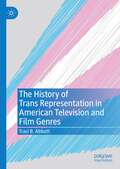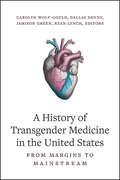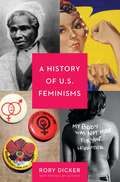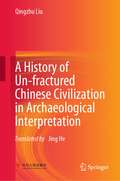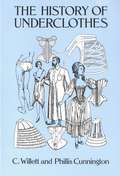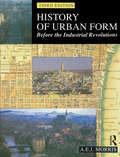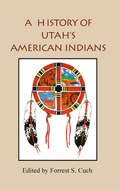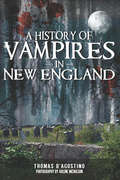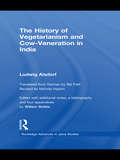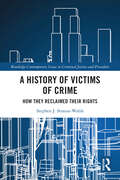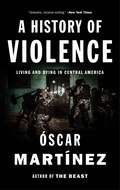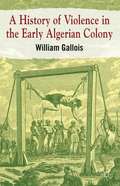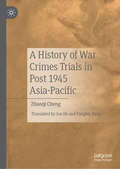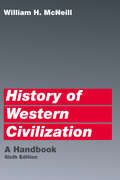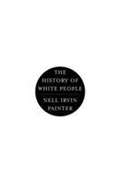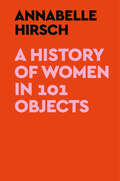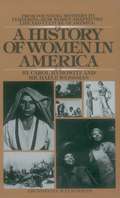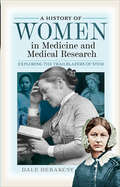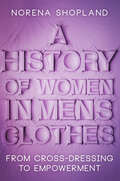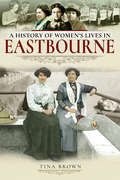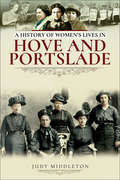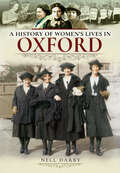- Table View
- List View
The History of Trans Representation in American Television and Film Genres
by Traci B. AbbottDue to the increase in transgender characters in scripted television and film in the 2010s, trans visibility has been presented as a relatively new phenomenon that has positively shifted the cis society’s acceptance of the trans community. This book counters this claim to assert that such representations actually present limited and harmful characterizations, as they have for decades. To do so, this book analyzes transgender narratives in scripted visual media from the 1960s to 2010s across a variety of genres, including independent and mainstream films and television dramatic series and sitcoms, judging not the veracity of such representations per se but dissecting their transphobia as a constant despite relevant shifts that have improved their veracity and variety. Already ingrained with their own ideological expectations, genres shift the framing of the trans character, particularly the relevance of their gender difference for cisgender characters and society. The popularity of trans characters within certain genres also provides a historical lineage that is examined against the progression of transgender rights activism and corresponding transphobic falsehoods, concluding that this popular medium continues to offer a limited and narrow conception of gender, the variability of the transgender experience, and the range of transgender identities.
A History of Transgender Medicine in the United States: From Margins to Mainstream
by Carolyn Wolf-Gould; Dallas Denny; Jamison Green; Kyan LynchThe most comprehensive history of transgender medicine to date, as told by more than forty scholars, physicians, psychologists, and activists from trans, gender-diverse, and allied medical communities.Arriving at a critical moment in the struggle for transgender rights, A History of Transgender Medicine in the United States takes an empathic approach to an embattled subject. Sweeping in scope and deeply personal in nature, this groundbreaking volume traces the development of transgender medicine across three centuries-centering the voices of transgender individuals, debunking myths about gender-affirming care, and empowering readers to grasp the complexities of this evolving field. More than forty contributors-including patients, advocates, physicians, psychologists, and scholars-weave an illuminating, sometimes surprising narrative of collaboration and conflict between trans people and the scientists who have studied and worked with them. An indispensable guide to understanding the current tumult surrounding trans health-care access in the United States, the volume underscores a crucial message: gender diversity is not a new phenomenon but an integral part of our shared human history.
A History of Twentieth-Century American Women’s Poetry
by Linda A. KinnahanA History of Twentieth-Century American Women's Poetry explores the genealogy of modern American verse by women from the early twentieth century to the millennium. Beginning with an extensive introduction that charts important theoretical contributions to the field, this History includes wide-ranging essays that illuminate the legacy of American women poets. Organized thematically, these essays survey the multilayered verse of such diverse poets as Edna St Vincent Millay, Marianne Moore, Anne Sexton, Adrienne Rich, and Audre Lorde. Written by a host of leading scholars, this History also devotes special attention to the lasting significance of feminist literary criticism. This book is of pivotal importance to the development of women's poetry in America and will serve as an invaluable reference for specialists and students alike.
A History of U.S. Feminisms (Seal Studies)
by Rory C. DickerThe History of U.S. Feminism is an introductory text designed to be used as supplementary material for first-year women's studies students or as a brush-up text for more advanced students. Covering the first, second, and third waves of feminism, The History of U.S. Feminism provides historical context of all the major events and players since the late nineteenth century through today.The chapters cover first-wave feminism, a period of feminist activity during the nineteenth and early twentieth century which focused primarily on gaining women's suffrage; second-wave feminism, which started in the '60s and lasted through the '80s and is best understood as emphasizing the connection between the personal and the political; and third-wave feminism, which started in the early '90s and arose in part from a backlash against the movements propagated by the second wave.
History of Ukraine - 2nd, Revised Edition
by Paul Robert MagocsiFirst published in 1996, A History of Ukraine quickly became the authoritative account of the evolution of Europe's second largest country. In this fully revised and expanded second edition, Paul Robert Magocsi examines recent developments in the country's history and uses new scholarship in order to expand our conception of the Ukrainian historical narrative.New chapters deal with the Crimean Khanate in the sixteenth and seventeenth centuries, and new research on the pre-historic Trypillians, the Italians of the Crimea and the Black Death, the Karaites, Ottoman and Crimean slavery, Soviet-era ethnic cleansing, and the Orange Revolution is incorporated. Magocsi has also thoroughly updated the many maps that appear throughout.Maintaining his depiction of the multicultural reality of past and present Ukraine, Magocsi has added new information on Ukraine's peoples and discusses Ukraine's diasporas. Comprehensive, innovative, and geared towards teaching, the second edition of A History of Ukraine is ideal for both teachers and students.
A History of Un-fractured Chinese Civilization in Archaeological Interpretation
by Qingzhu LiuThis book presents an archeological interpretation of the history of Chinese civilization. Tracing back from recent history to the distant past, it explores the breadth of Chinese civilization. Using archeological remains and cultural relics as starting points and approaching the cultural dimension from material perspectives, it presents a panoramic view of China’s civilizational continuity, together with its ideological and cultural characteristics. Featuring a wealth of illustrations (including photos of cultural relics and sites, archeological surveys, etc.) and texts written in easy-to-understand language, it offers an engaging read without sacrificing academic quality. The main components of “civilization” are addressed: capital archeology, mausoleum archeology, ritual wares and architecture archeology, as well as written language. The book offers a unique resource for archeology scholars and majors, as well as general readers who are interested in Chinese archeology and history.
The History of Underclothes
by C. Willett Cunnington PhiIlis Cunnington". . . thoroughness and most impressive scholarship . . . much entertaining detail and . . . pleasant humour." — The Times Literary Supplement (London)Underwear — practical garments with a utilitarian function or body coverings that serve an erotic purpose? As this fascinating and intelligently written study shows, the role played by underclothing over the last several centuries has been a varied one.In a well-documented, profusely illustrated volume combining impressive scholarship with an entertaining, often humorous style, two distinguished clothing historians consider undergarments worn by the English over the past 600 years. Beginning with the Middle Ages, the authors cover centuries of clothing history, including the Tudor period, the Restoration, the Victorian and Edwardian eras, and the twentieth century up to the eve of World War II. Drawing on extensive, research, the Cunningtons illuminate the role and function of underwear: it protected the wearer against the elements, supported costume shapes, served as an erotic stimulus, symbolized class distinctions, and fulfilled other social, sanitary, and economic functions. Enhancing the detailed, comprehensive text are more than 100 period illustrations and photographs depicting a laced-up bodice of the twelfth century, embroidered linen drawers of the sixteenth century, a hooped petticoat support in bentwood (c. 1750), footed long drawers (1795), nineteenth-century bustles, early nineteenth-century corsets for men, "Frillies for the Tiny Lady" (1939), and much more. A bibliography, appendix, and index complete a valuable reference work that will appeal to costume historians, sociologists, and other readers.
History of Urban Form Before the Industrial Revolution
by A.E.J. MorrisProvides an international history of urban development, from its origins to the industrial revolution. This well established book maintains the high standard of information found in the previous two editions, describing the physical results of some 5000 years of urban activity. It explains and develops the concept of 'unplanned' cities that grow organically, in contrast with 'planned' cities that were shaped in response to urban form determinants. Spread throughout the texts are copious illustrations from a wealth of sources, including cartographic urban records, aerial and other photographs, original drawings and the author's numerous analytical line drawings.
A History of Utah's American Indians
by Forrest S. CuchA comprehensive history of the six Native American tribes of Utah, from an Indigenous perspective.The valleys, mountains, and deserts of Utah have been home to native peoples for thousands of years. Like peoples around the word, Utah&’s native inhabitants organized themselves in family units, groups, bands, clans, and tribes. Today, six Indian tribes in Utah are recognized as official entities. They include the Northwestern Shoshone, the Goshutes, the Paiutes, the Utes, the White Mesa or Southern Utes, and the Navajos (Dineh). Each tribe has its own government. Tribe members are citizens of Utah and the United States; however, lines of distinction both within the tribes and with the greater society at large have not always been clear. Migration, interaction, war, trade, intermarriage, common threats, and other challenges have made relationships and affiliations more fluid than might be expected.In this volume, the editor and contributors endeavor to write the history of Utah&’s first residents from an Indian perspective. An introductory chapter provides an overview of Utah&’s American Indians and a concluding chapter summarizes the issues and concerns of contemporary Indians and their leaders. Chapters on each of the six tribes look at origin stories, religion, politics, education, folkways, family life, social activities, economic issues, and important events. They provide an introduction to the rich heritage of Utah&’s native peoples. This book includes chapters by David Begay, Dennis Defa, Clifford Duncan, Ronald Holt, Nancy Maryboy, Robert McPherson, Mae Parry, Gary Tom, and Mary Jane Yazzie.This book is a joint project of the Utah Division of Indian Affairs and the Utah State Historical Society. It is distributed to the book trade by Utah State University Press.
A History of Vampires in New England (Haunted America)
by Thomas D'AgostinoThe author of A Guide to Haunted New England lifts the coffin lid on the region&’s folklore and legends of the undead. New England is rich in history and mystery. Numerous sleepy little towns and farming communities distinguish the region&’s scenic tranquility. But not long ago, New Englanders lived in fear of spectral ghouls believed to rise from their graves and visit family members in the night to suck their lives away. Although the word &“vampire&” was never spoken, scores of families disinterred loved ones during the eighteenth and nineteenth centuries searching for telltale signs that one of them might be what is now referred to as the New England vampire. &“In his remarkable book . . . Thomas D&’Agostino details the longstanding belief among New Englanders that supernatural entities were responsible for the disease called consumption.&”—Crime Capsule Includes photos! Praise for A Guide to Haunted New England &“Fun, charming . . . includes not only locales with reported ghosts, but also sites with macabre (though not haunted) histories.&”—True Crime Librarian &“Anyone interested in exploring the haunted, macabre and abandoned throughout New England knows they can count on D&’Agostino to find out more about the site&’s history, past sightings and how to find them.&”—Mobile RVing
The History of Vegetarianism and Cow-Veneration in India (Routledge Advances in Jaina Studies)
by Ludwig AlsdorfFor the first time, this influential study by Ludwig Alsdorf is made available to an English speaking audience, translated by Bal Patil. It focuses on two of the most pertinent issues in Indian religion, the history of vegetarianism and cow-veneration, and its historical approach remains relevant to this day. With reference to significant brahminical texts, such as key chapters of the Book of Manu, the book centres on the author’s analysis of the role of Jinism in the history of vegetarianism. The author explores the history of meat-eating in India and its relationship to religious thought and custom, and searches for solutions to the problem of cattle veneration. Besides a comprehensive translation of the original German manuscript "Beiträge zur Geschichte von Vegetarismus und Rinderverehrung in Indien", four important articles directly related to Alsdorf’s work by Kapadia, Heesterman and Schmidt are made available in this new edition. These additional contributions and careful notes by the editor Willem Bollée add a modern perspective to a study that remains a key reference for students and scholars of Religious Studies, Asian Studies and History.
A History of Victims of Crime: How they Reclaimed their Rights (Routledge Contemporary Issues in Criminal Justice and Procedure)
by Stephen J. Strauss-WalshThis book examines the evolution of the contemporary crime victim’s procedural place within modern Western societies. Taking the history of the Irish crime victim as a case study, the work charts the place of victims within criminal justice over time. This evolves from the expansive latitude that they had during the eighteenth century, to their major relegation to witness and informer in the nineteenth, and back to a more contemporary recapturing of some of their previous centrality. The book also studies what this has meant for the position of suspects and offenders as well as the population more generally. Therefore, some analysis is devoted to examining its impact on an offender’s right to fair trial and social forms. It is held that the modern crime victim has transcended its position of marginality. This happened not only in law, but as the consequence of the victim’s new role as a key sociopolitical stakeholder. This work flags the importance of victim rights conferrals, and the social transformations that engendered such trends. In this way victim re-emergence is evidenced as being not just a legal change, but a consequence of several more recent sociocultural transformations in our societies. The book will be of interest to researchers, academics, and policy makers in criminal law, human rights law, criminology, and legal history.
A History of Violence
by Oscar Martinez Daniela Maria Ugaz John WashingtonHeartbreaking immersion into the lives of people enduring extreme violence in Central America El Salvador and Honduras have had the highest homicide rates in the world over the past ten years. Óscar Martínez, author of The Beast, which was named one of the best books of the year by the Economist and the Financial Times, shares a beautiful and immersive account of life in one of the most violent places on earth. Martinez travels to Nicaraguan fishing towns, southern Mexican brothels where Central American women are trafficked, isolated Guatemalan jungle villages and crime-ridden Salvadoran slums. With his precise and empathetic reporting, he reveals the underbelly of some of the most dangerous places in the world, going undercover to drink with narcos, accompanying police patrols, riding in trafficking boats and hiding out with a gang informer. The result is an unforgettable portrait of a region of fear, helping to explain why migrants have been fleeing the area by the millions.From the Hardcover edition.
A History of Violence in the Early Algerian Colony
by William GalloisUsing newly-discovered documentation from the French military archives, A History of Violence in the Early Algerian Colony offers a comprehensive study of the forms of violence adopted by the French Army in Africa. Its coverage ranges from detailed case studies of massacres to the question of whether a genocide took place in Algeria.
A History of War Crimes Trials in Post 1945 Asia-Pacific
by Zhaoqi ChengWritten by the Director of the Tokyo Trial Research Centre at China's Shanghai Jiao Tong University, this book provides a unique analysis of war crime trials in Asia-Pacific after World War II. It offers a comprehensive review of key events during this period, covering preparations for the Trial, examining the role of the War Crimes Commission of the United Nations as well as offering a new analysis of the trial itself. Addressing the question of conventional war crimes, crimes against humanity, crimes against peace (such as the Pearl Harbor Incident) and violations of warfare law, it follows up with a discussion of post-trial events and the fate of war criminals on trial. Additionally, it examines other Japanese war crime trials which happened in Asia, as well as considering the legacy of the Tokyo trial itself, and the foundation of a new Post-War International Order in East Asia.
History of Western Civilization: A Handbook
by William H. McNeillRenowned historian William H. McNeil provides a brilliant narrative chronology of the development of Western civilization, representing its socio-political as well as cultural aspects. This sixth edition includes new material for the twentieth-century period and completely revised bibliographies. An invaluable tool for the study of Western civilization, the Handbook is an essential complement to readings in primary and secondary sources such as those in the nine-volume University of Chicago Readings in Western Civilization.
The History of White People
by Nell Irvin PainterEver since the Enlightenment, race theory and its inevitable partner, racism, have followed a crooked road, constructed by dominant peoples to justify their domination of others. Filling a huge gap in historical literature that long focused on the non-white, eminent historian Nell Irvin Painter guides us through more than two thousand years of Western civilization, tracing not only the invention of the idea of race but also the frequent worship of "whiteness" for economic, social, scientific, and political ends. Our story begins in Greek and Roman antiquity, where the concept of race did not exist, only geography and the opportunity to conquer and enslave others. Not until the eighteenth century did an obsession with whiteness flourish, with the German invention of the notion of Caucasian beauty. This theory made northern Europeans into "Saxons," "Anglo-Saxons," and "Teutons," envisioned as uniquely handsome natural rulers. Here was a worldview congenial to northern Europeans bent on empire. There followed an explosion of theories of race, now focusing on racial temperament as well as skin color. Spread by such intellectuals as Madame de Stael and Thomas Carlyle, white race theory soon reached North America with a vengeance. Its chief spokesman, Ralph Waldo Emerson, did the most to label Anglo-Saxons-icons of beauty and virtue-as the only true Americans. It was an ideal that excluded not only blacks but also all ethnic groups not of Protestant, northern European background. The Irish and Native Americans were out and, later, so were the Chinese, Jews, Italians, Slavs, and Greeks-all deemed racially alien. Did immigrations threaten the very existence of America? Americans were assumed to be white, but who among poor immigrants could become truly American? A tortured and convoluted series of scientific explorations developed-theories intended to keep Anglo-Saxons at the top: the ever-popular measurement of skulls, the powerful eugenics movement, and highly biased intelligence tests-all designed to keep working people out and down. As Painter reveals, power-supported by economics, science, and politics-continued to drive exclusionary notions of whiteness until, deep into the twentieth century, political realities enlarged the category of truly American. A story filled with towering historical figures, The History of White People forcefully reminds us that the concept of one white race is a recent invention. The meaning, importance, and realty of this all-too-human thesis of race have buckled under the weight of a long and rich unfolding of events.
A History of Women in 101 Objects
by Annabelle HirschDiscover the hidden history of women—and the world—through this visual exploration of intimate objects and the surprising, sometimes shocking stories behind them.&“I adored this book!&”—Olivia ColmanThis is a neglected history. Not a sweeping, definitive, exhaustive history of the world but something quieter, more intimate and particular: a single journey, picked out in 101 objects, through the fascinating, manifold, and too often overlooked histories of women.With engaging prose, compelling stories, and a beautiful full-page image of each object, Annabelle Hirsch&’s book contains a curated and diverse compendium of women and their things, uncovering the thoughts and feelings at the heart of women&’s daily lives. The result is an intimate and stirring alternative history of humans in the world. The objects date from prehistory to today and are assembled chronologically to show the evolution of how women were perceived by others, how they perceived themselves, how they fought for freedom. Some (like a sixteenth-century glass dildo) are objects of female pleasure, some (a thumbscrew) of female subjugation. These are artifacts of women celebrated by history and of women unfairly forgotten by it. With variety and nuance, A History of Women in 101 Objects cracks open the fissures of what we think we know in order to illuminate a much richer retelling: What do handprints on early cave paintings tell us about the role of women in hunting? How is a cell phone related to femicides? What does Kim Kardashian&’s diamond ring have to do with Elena Ferrante?Wide-ranging, subversive, witty, and superbly researched, this is a book that upends all our assumptions about, and presentations of, the past, proving that it has always been as complicated and fascinating as the women who peopled it.
A History of Women in America: From Founding Mothers to Feminists-How Women Shaped the Life and Culture of America
by Carol Hymowitz Michaele WeissmanFrom colonial to modern-day times this narrative history, incorporating first-person accounts, traces the development of women's roles in America. Against the backdrop of major historical events and movements, the authors examine the issues that changed the roles and lives of women in our society. Note: This edition does not include photographs.
A History of Women in Medicine and Medical Research: Exploring the Trailblazers of STEM
by Dale DeBakcsyIn the nineteenth century, a small but dedicated group of European and American women rose to agitate for the inclusion of women in the medical profession. It is a historic tale that we have told and retold for decades, but it is far from where the story of women as physicians and healers begins. Stretching back into deepest antiquity, we possess accounts of women who were consulted by emperors and paupers alike for their medical expertise. They were surgeons, apothecaries, midwives, university lecturers, and medical researchers in correspondence with the most learned societies of their time. And then it all came crashing down. A History of Women in Medicine and Medical Research is the story of the women who participated in that early Golden Age, and of a medical establishment closing ranks against them so effectively that, by the early Victorian era, they not only were barred from practicing medicine, but from so much as stepping into a classroom where medical topics were being discussed. It is the story of that intrepid band of reformers and pioneers who built back the women's medical profession from the ashes and constructed a thriving new community of researchers and practitioners who within a century had retaken not only the ground that had been lost, but boldly advanced to levels of fame and achievement unimaginable to any previous era. Told through in-depth accounts of the lives of the pioneers and practitioners who built and rebuilt the women's medical movement, this title dives into the lives of not only legendary figures like Florence Nightingale, Gertrude Elion, Rosalyn Yalow, and Elizabeth Blackwell, but visits women the world over whose medical contributions broke down doors and advanced the cause of women's and world health, like the revolutionary medieval physician Trota of Salerno, the pioneering eighteenth century midwife and businesswoman Madame du Coudray, the microbiological research trailblazer Mary Putnam Jacobi, and the HIV researcher and world epidemic response coordinator Francoise Barre-Sinoussi. With over 140 stories spanning three millennia of global medicine, this book shines a light on the unknown heroes, towering discoveries, tragic missteps, and profound struggles that have accompanied the Rise, Fall, and Rebirth of the women's medical profession.
A History of Women in Men's Clothes: From Cross-Dressing to Empowerment
by Norena ShoplandTraditionally, historic women have been seen as bound by social conventions, unable to travel unless accompanied and limited in their ability to do what they want when they want. But thousands of women broke those rules, put on banned clothing and traveled, worked and even lived whole lives as men. As access to novels and newspapers increased in the nineteenth century so did the number of women defying Biblical and social restrictions. They copied each other’s motives and excuses and moved into the world of men. Most were working-class women who either needed to or wanted to, break away from constricted lives; women who wanted to watch a hanging or visit a museum, to see family or escape domestic abuse, some wanted to earn a decent living when women’s wages could not keep a family. The reasons were myriad. Some were quickly arrested and put on display in court, hoping to deter other women from such shameful behavior, but many more got away with it. For the first time, A History of Women in Men’s Clothes looks at those thousands of individuals who broke conventions in the only way they could, by disguising themselves either for a brief moment or a whole life. Daring and bold, this is the story of the women who defied social convention to live their lives as they chose, from simply wanting more independence to move and live freely, to transgender and homosexual women cross-dressing to express themselves, this is women’s fight to wear trousers.
A History of Women in Russia: From Earliest Times to the Present
by Barbara Evans ClementsA survey of the key political, economic, social, and cultural developments in Russian women’s history from 900 to 2010, and their impact on the nation.Synthesizing several decades of scholarship by historians East and West, Barbara Evans Clements traces the major developments in the history of women in Russia and their impact on the history of the nation. Sketching lived experiences across the centuries, she demonstrates the key roles that women played in shaping Russia’s political, economic, social, and cultural development for over a millennium. The story Clements tells is one of hardship and endurance, but also one of achievement by women who, for example, promoted the conversion to Christianity, governed estates, created great art, rebelled against the government, established charities, built the tanks that rolled into Berlin in 1945, and flew the planes that strafed the retreating Wehrmacht. This daunting and complex history is presented in an engaging survey that integrates this scholarship into the field of Russian and post-Soviet history.“The product of a lifetime of engagement by one of the preeminent authorities on the history of Russian women, the book reflects the author’s deep expertise in primary sources as well as her familiarity with the secondary literature.” —Choi Chatterjee, California State University Los Angeles“A significant achievement in scholarship on Russian women and gender. . . . Among this text’s many strengths are its lucidity, readability, and engaging synthesis of a large number of both primary and secondary sources. . . . Its erudite contextualization of the history of Russian women within a larger European framework ensures its interest for and accessibility to a wide readership, especially those outside of the Slavic field.” —Slavic and East European Journal“Clements’s writing is engaging, clear, and jargon free, making this book easily accessible to a general audience. . . . Highly recommended.” —Choice“This daunting and complex history is presented in an engaging survey that integrates this scholarship into the field of Russian and post-Soviet history.” —Journal of Turkish Weekly
A History of Women's Lives in Eastbourne
by Tina BrownA historian examines the developments in women&’s lives over a period from 1850 to 1950 in the famous southeastern England seaside town. The southeast coastal town of Eastbourne is probably best known today as a popular holiday resort frequented by the retired generation. It has long, golden beaches and a gentile pace of life and, from that point of view, little has really changed from the mid-1850s to today. However, for the women of the town and their advancements and achievements, a significant period was between 1850 and 1950, when changes in medicine, education, family life, and the right to vote played an important part in their lives. The First and Second World Wars also brought about their own changes and challenges. A History of Women&’s Lives in Eastbourne delves deep into these historical subjects and more.
A History of Women's Lives in Hove and Portslade
by Judy MiddletonThis book looks at the lives of the women from Hove and Portslade, ranging from artists, musicians, writers, performers, reformers, pioneering doctors and business-women to those employed in factories, shops, laundries and as domestic servants, not forgetting, of course, women's contribution to war-work in both of the world wars. There are facts about their ordinary lives, birth, marriage and death; their education; their leisure activities from guns to cycling, the gym, swimming and horse riding.It is also appropriate to reflect on the Votes for Women movement, when brave souls battled against prejudice to achieve the franchise. Not all women felt the same, of course, and although there was apathy at first, Brighton and Hove was home to an early group of suffragists who were passionate in their beliefs but disliked the violence embraced by the suffragettes.If you ever thought women deserved more than being a mere footnote in history, then this is the book for you.
A History of Women's Lives in Oxford
by Nell DarbyUnderneath the dreaming spires of Oxford&’s world-famous university, generations of women have lived their lives, fighting for the right to study there, and for a role within the city&’s educational, political and social spheres. Although a few of these women&’s names have been recorded for posterity, they have been largely because of their association with worthy or famous men; in this book, though, their own lives are detailed, along with those who have been largely omitted from history. Women&’s lives have always been less recorded than those of men; where a woman helped her husband with his business, this help may not have been formally recorded in the census returns, and the details of jobs recorded there might not reflect the full-scale of women&’s work and responsibilities. So here, learn about the variety of work women undertook; their education, their social lives, and their attempts to carve out a valuable role for themselves. Learn too of the problems they faced in living their lives: poverty, prison, suicide, or even murder. This is no pretty picture of Oxford life designed for tourist brochures; instead, it aims to take a snapshot of the varied experiences of the city&’s female population over the course of a century.
